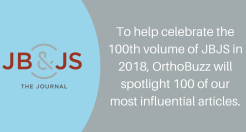 Under one name or another, The Journal of Bone & Joint Surgery has published quality orthopaedic content spanning three centuries. In 1919, our publication was called the Journal of Orthopaedic Surgery, and the first volume of that journal was Volume 1 of what we know today as JBJS.
Under one name or another, The Journal of Bone & Joint Surgery has published quality orthopaedic content spanning three centuries. In 1919, our publication was called the Journal of Orthopaedic Surgery, and the first volume of that journal was Volume 1 of what we know today as JBJS.
Thus, the 24 issues we turn out in 2018 will constitute our 100th volume. To help celebrate this milestone, throughout the year we will be spotlighting 100 of the most influential JBJS articles on OrthoBuzz, making the original content openly accessible for a limited time.
Unlike the scientific rigor of Journal content, the selection of this list was not entirely scientific. About half we picked from “JBJS Classics,” which were chosen previously by current and past JBJS Editors-in-Chief and Deputy Editors. We also selected JBJS articles that have been cited more than 1,000 times in other publications, according to Google Scholar search results. Finally, we considered “activity” on the Web of Science and The Journal’s websites.
We hope you enjoy and benefit from reading these groundbreaking articles from JBJS, as we mark our 100th volume. Here are two more:
The Outcome and Repair Integrity of Completely Arthroscopically Repaired Large and Massive Rotator Cuff Tears
L M Galatz, C M Ball, S A Teefey, W D Middleton, K Yamaguchi: JBJS, 2004 February; 86 (2): 219
In one of the earliest studies to investigate the relationship between the anatomic integrity of arthroscopic rotator cuff repair and clinical outcome, these authors found that the rate of recurrent defects was high but that at 12 months after surgery, patients experienced excellent pain relief and functional improvement. However, at the 2-year follow-up, the clinical results had deteriorated substantially. Investigations into the relationship between cuff-repair integrity and clinical outcomes are ongoing.
The Biological Effect of Continuous Passive Motion on the Healing of Full-thickness Defects in Articular Cartilage: An Experimental Investigation in the Rabbit
R B Salter, D F Simmonds, B W Malcolm, E J Rumble, D Macmichael, N D Clements: JBJS, 1980 January; 62 (8): 1232
In this paper, Salter and colleagues hypothesized that “continuous passive motion [CPM] of a synovial joint in vivo would have a beneficial biological effect on the healing of full-thickness defects in articular cartilage.” They found that CPM stimulated more rapid and complete cartilage restoration than either immobilization or intermittent active motion, and since then CPM has been commonly used in humans after cartilage repair. However, CPM’s actual efficacy in people—after cartilage repair or total knee arthroplasty—remains controversial.


